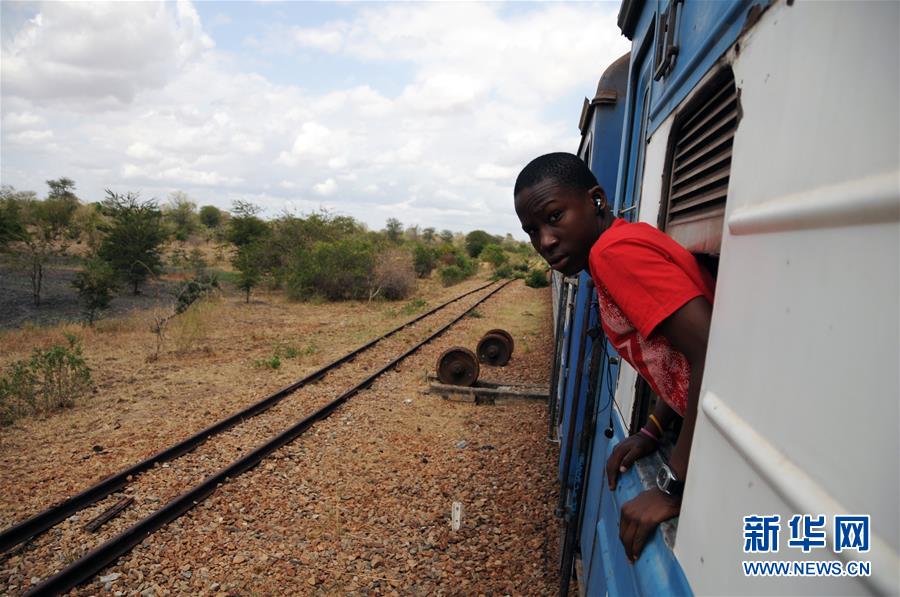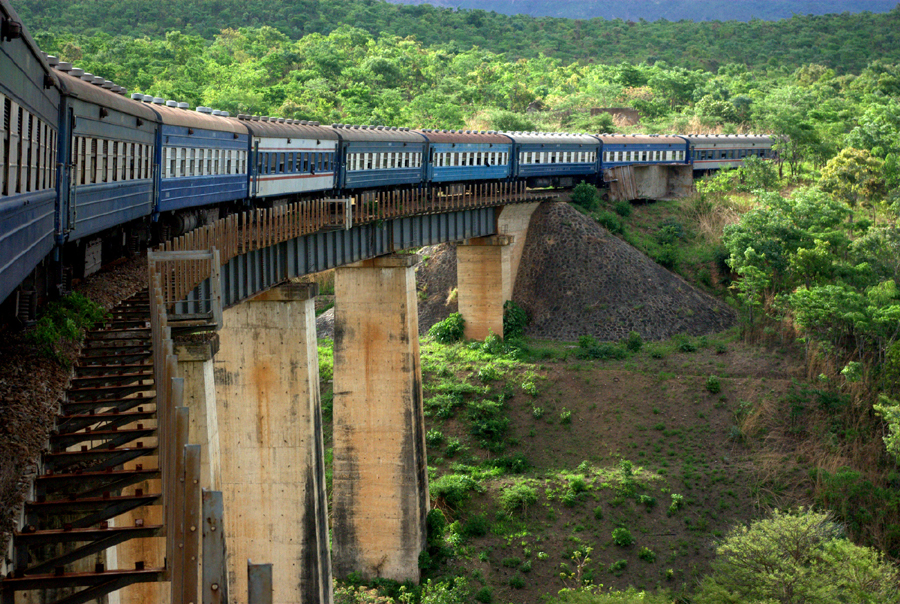Chinese aid helps put African nations on track
TAZARA is just a tiny part of China's long-term and continuous foreign aid to African countries. Since 1956, all countries on the continent that have established diplomatic relations with China have received Chinese aid in various forms.
As the afternoon wore on, the crowd at the railway station in the Tanzanian port city of Dar es Salaam kept swelling. Loudspeakers mounted in the waiting room continued to announce new departure times.
A boy is pictured inside a train traveling on the Tanzania-Zambia (TAZARA) Railway, Sept 17, 2011. The rail link has transported more than 30 million metric tons of cargo and over 40 million passengers since it started operating in 1976. [Photo/Xinhua]
Asha Maimuna, a middle-aged passenger, noted wryly: "Our safe arrival is important, not really the departure time."
She was traveling to Mbeya, a trip of 813 kilometers, to visit her parents. Some roads are impassable, she said, and journeys overland are prone to accidents.
"The Makuba Express train is a necessity for many of us, despite the long delays and sluggish speed," Maimuna said.
The Tanzania-Zambia Railway Authority, or TAZARA, has been a lifeline for landlocked Zambia, creating innumerable job opportunities for the two countries as the line snakes 1,860 km from Dar es Salaam to the copper town of Kapiri Mposhi in Zambia. It is one of China's efforts to aid developing countries.
A white paper – The Right to Development: China's Philosophy, Practice and Contribution – which was released in December 2016, said China had provided some 400 billion yuan (about US$56 billion) in development aid to 166 countries and international organizations over the past 60 years.
It has trained more than 12 million personnel from developing countries and sent around 600,000 people to assist in the development in other nations. Of those, 700 have given their lives, the white paper said.
Assistance from China has made a significant contribution to improving the lives of those in the recipient countries.
For the past 43 years, Boniface Zimba has been taking the line operated by the Tanzania-Zambia Railway Authority to visit his family in rural Zambia.
Sometimes, the 79-year-old runs into former workers from the authority, which he left 24 years ago. They always discuss how the China-built railway has boosted the economy and changed their lives.
"We were proud to build it," Zimba said. He left his mining job in 1970 to join 13,500 Chinese technical and engineering personnel and 38,000 Tanzanian and Zambian workers who helped establish the rail authority.
Zimba said the steady job and good pay enabled him and his wife to start a family and provide their eight children with an education.
The authority was funded by China and established between 1970 and 1975, with commercial operations starting in July 1976. It linked Kapiri Mposhi in Zambia to Dar es Salaam on the Tanzanian coast, providing freight and passenger services.
Wang Luo, director of the Institute of International Development Cooperation, responsible to the Chinese Academy of International Trade and Economic Cooperation at the Ministry of Commerce, said, "The railway has been an economic catalyst for eastern and southern African nations and a symbol of the friendship between China and Africa."
Emmanuel Matambo, an analyst at the Center for Africa-China Studies at the University of Johannesburg in South Africa, said, "The Tanzania-Zambia railway line played a seminal role in demonstrating China's solidarity with anti-colonial and anti-apartheid agitation in Africa."
He added that despite not functioning at its best, the line's ideological importance has been so influential that it has dispelled many arguments about China's alleged colonial or harmful designs on Africa.
"The railway authority was thus an altruistic contribution to Africa from a country that wants to be seen as a kindred spirit to the continent. It created the trust that China still enjoys in Africa today," Matambo said.
The TAZARA Railway links the Tanzanian port of Dar es Salaam with the town of Kapiri Mposhi in Zambia. [Photo/China Daily]
Maximum efforts
The idea to connect central and southern African countries with the east coast by a rail link can be traced as far back as 1947. Western nations were initially approached for help in building the line, but they rebuffed the idea, insisting that the project was not economically viable, according to the railway authority.
Although China was experiencing difficult times itself, it made maximum efforts to finance it as a turnkey project – one that is constructed so that it can be sold to a buyer as a completed project.
In 1970, Chinese inspectors walked for nine months from Tanzania to Zambia to mark the route. The difficulties in building the railway were immense, and more than 160 workers, including 64 Chinese, died during the construction, according to the authority.
Mark Mwandosya, former Tanzanian minister of communication and transport, said, "Those of us who are fortunate enough to have witnessed the construction will forever be grateful to China."
Official figures show that TAZARA has transported more than 30 million metric tons of cargo and over 40 million passengers since it started operating in 1976. During this time, China has offered technical support to enable the authority to function well.
The rail line has seen Kapiri Mposhi, which used to be a sleepy town, grow into a vibrant hub with a population of 300,000. It has also seen hotels and restaurants mushrooming to serve traders and workers from the railway authority.
Li Dechao, deputy managing director at China Civil Engineering Construction Co in Tanzania – TAZARA's Chinese operating company – said, "This infrastructure is a very important link to hinterland areas."
He added that as the rail line passes through underdeveloped rural areas in Tanzania and Zambia, it has become the lifeblood of local economic development.
In addition, it has fostered positive relations between Tanzania and Zambia due to the shared growth it has brought. Analysts in Africa believe that these gains from the project exemplify the anticipated benefits from future Sino-African cooperation.
TAZARA is just a tiny part of China's long-term and continuous foreign aid to African countries. Since 1956, all countries on the continent that have established diplomatic relations with China have received Chinese aid in various forms, according to Wang, from the Institute of International Development Cooperation.
"Africa has been in great need of foreign aid, as the continent has a large number of developing countries," she said. "China has attached great importance to the development of Africa, and more than 40 percent of China's foreign aid currently goes to the continent."
After the People's Republic of China was founded in 1949, the Chinese government decided to help developing countries that were in need, as well as promote the country's standing on the world stage.
At the time, Asian and African countries were winning their independence and were eager to obtain external development aid. Wang said that in view of this, and to widen its diplomatic reach, China strengthened its cooperation with and assistance to developing countries on both continents.



